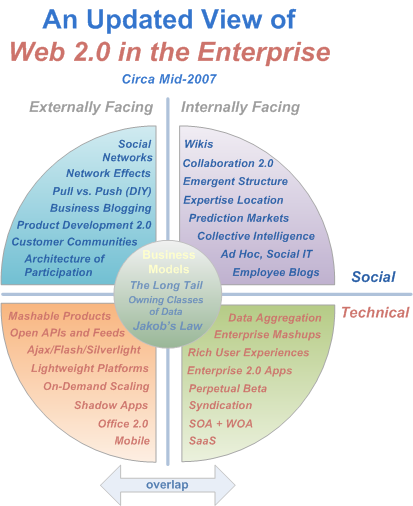Using Web 2.0 in the enterprise
September 27, 2007
For over quite some time now, there has been a great interest in using Web 2.0 concepts withing the enterprise. The whole concept of Web 2.0 has been evolving and has gained iconic status in business and technical worlds alike.
Web 2.0 has many concepts associated with it – blogs, wikis, mashups, social networking, RSS, content tagging and many more. Most of these concepts are based on an user centric approach where the user is the focal point of action/attention. Enterprises are hence realizing that it makes a lot of sense to replicate these concepts within their organization to improve collaboration and communication and hence improve productivity.
However using Web 2.0 concepts within an enterprise requires a drastic mind shift within people. Information is now openly available, and people can easily express their views on the same. This will need to go hand in hand with a good change management and user education process.
Below is a diagram that I find very intuitive about Enterprise 2.0, courtesy Dion Hinchcliffe from ZDNET

The idea here is look at enterprise 2.0 from two prespectives – Internal facing and extrernal facing. Here’s my take on the most important faces of Enterprise 2.0
- Collaboration 2.0 – An unoffical term for the collaboration strategies within the enterpise, this seems to be gaining a lot of traction within enterprises. The ability for multiple people to work on a document and then have preset workflows which get kicked in, are very useful and can play a key role in improving efficiency and productivity. SharePoint (or Microsoft Office SharePoint Server 2007) is a product which I think holds a lot of promise in this space and clearly there is a lot of traction around using MOSS 2007 within large enterprises and ISVs.
Other collaboration tools which are popularly used within enterprises include Wikis, which hold a lot of promise for easy information sharing and editing. - Syndication/RSS feeds – This would enable everyone to keep in touch with items most important to them through notifications, feeds etc
- Informal modes of communication – This has led to the use og instant messaging services, SMS, etc for communication with the enterprise.
- Rich User Experience (UX) – This is becoming ever so important in the Enterprise 2.0 era. The ability to engage users and have them get their work done easily is of primary importance. Some examples include Rich Internet applications built on AJAX, Flex, Flash, and Silverlight. Other concepts such as Office Business Applications (OBA) enable pulling in data from Line of business systems and surface them up in portals with a rich user experience.
- Employee blogs – Blogs are an ideal channel for employees to showcase their ideas and also put up their questions, opinions etc. Blogs are also being used as marketing tools where companies primarily use their blogs/ employee blogs as showcase pieces or even to break some important news about product releases etc to the world.
- Software as a Service (SaaS) – Desktop software is becoming passe` in the web 2.0 world and running softwares on the network (or cloud) is potentially one of the best software models which has a lot of potential.

